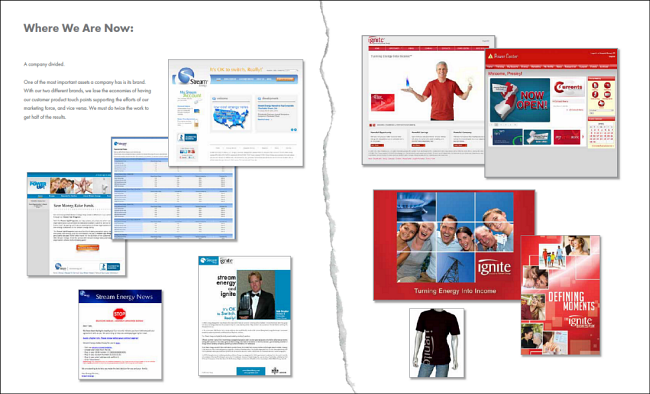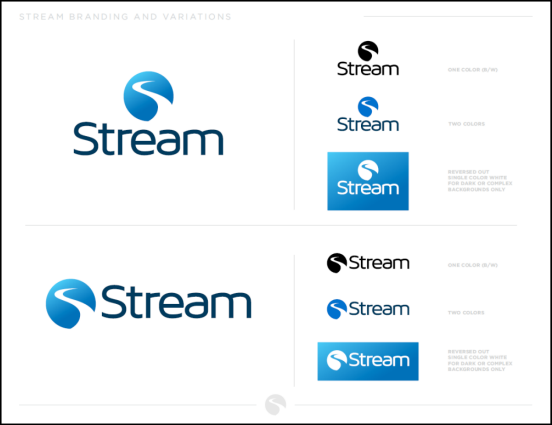by
David Kirkpatrick, Reporter
THE CUSTOMER
Stream, previously known as Stream Energy, offers both energy and mobile services. This case study covers the company’s rebranding effort as the company moved from Stream Energy to Stream.
As Stream Energy, the business had two distinct sets of customers. Stream is a network marketing, direct sales organization and a reseller of energy in states that allow that service. One group of Stream customers is retail energy consumers and the second is B2B network marketing business customers who are entrepreneurs looking for business opportunities — part-time and small — reselling energy services to the retail energy customers.
CHALLENGE
Kerry Brown, Chief Marketing Officer, Stream, was brought to the company to look at the next ten years for Stream. The future was a concern for this company because there was a decline in overall adoption in the energy marketplace. His role was to, in Brown’s words, "either revamp or boost sales in network marketing" — Stream’s B2B business.
One immediate issue was how to expand into non-deregulated energy states, such as California and Arizona. Only six states have deregulated energy. The second issue was
that the two distinct aspects of Stream Energy each had a specific branding color scheme. The retail energy side of the business was branded with blue and white while the B2B network marketing side of the business was branded with red and black.

Click here to see the full version of this creative sample
Brown said, "We ended up merging the two brands and we decided that, in order to truly expand out of our current states (our current market), we were going to have to bring the two brands together — merge them, over a period of about 18-months, into a single brand."
He added that the brand "then [had to] get ready for a national expansion of products and services outside of energy."
The end result of this effort was
a change from Stream Energy to Stream. Mobile was also added to the existing energy product mix.

Click here to see the full version of this creative sample
CAMPAIGN
Brown said that the entire rebranding process began with speaking to all of Stream’s corporate employees as well as its top sales people.
Step #1. Start with a discovery process
The initial phase of discovery and speaking with Stream’s corporate employees and top sales people lasted a couple of months. This phase included background studies on Stream’s different audiences and their needs, internal interviews and looking into website analytics. The process also included finding out where most brand engagements and interactivity were happening.
"During this discovery stage, it became pretty clear that, even though [Stream] had two dramatically different brands, customers and associates and employees were [all] confused by it," said Brown. "After a series of surveys and interviews, bringing the brands together was — to be honest — more welcomed and appreciated than we were anticipating."
A major aspect of the process involved a series of in-person interviews — around 20 with corporate stakeholders and another 20-30 with top sales people.
After coming up with a rebranding plan, Brown said that the team went back to those interviewees and showed them where the input from the interview process was taken seriously, particularly with website usability and systems tools that everyone was already familiar with.
Step #2. Create mock-up examples of potential new branding
With results of the discovery process in hand, Brown’s creative team analyzed the results and put together a presentation for the board and executive team at Stream. This was meant to walk them through the data and results as well as the team’s recommendation for unifying the company’s branding.
The meeting included mock-ups of the potential new brand and the brainstorm results for what Stream’s future product offering might look like beyond just energy.
Brown said, "We knew that the company wanted to stay in the services arena — energy was always going to be their base — but what other kind of products would fall in line in our run as part of the Stream family two years down the road?"
The mock-ups included new copy and messaging, wire frames and even full mock-ups of the website.
"When we [presented] what the future of the company might look like, it was very tangible," Brown said. "I think that the key is, if you want somebody to buy into your vision, you’ve got to show them what that vision looks like in your head instead of just expecting that they are going to interpret what you’re saying and paint the same picture. You’ve actually got to show it to them."
Step #3. Work to preserve branding history with the rebranding
Even though the two aspects of Stream Energy’s business had different branding, Brown said it was important to not lose the ten years of culture and history that those older brands had. The new brand was meant to feel consistent with the old one while still making the rebranding "new and fresh."
For example, the rebranding replaced the red color scheme of the old B2B brand with a consistent blue and white look that echoed the previous B2C brand color scheme. At the same time, elements of the old B2B branding messaging were incorporated into the new brand as well as some of the website and navigation of the old B2B website.
Step #4. Introduce the new branding
After getting approval from Stream’s leadership, the new branding was rolled out over an 18-month period. During this time, company stakeholders where given regular updates that explained what was being done, why it was being done and the results of the surveys and interviews.
Brown said it was important to show the stakeholders "elements of the new brand as it was being built so they felt like they were engaged in the process."
Previously the B2C brand had the domain name "streamenergy.net" and the B2B brand was "igniteinc.com." The new brand was released under a single domain — "mystream.com." When the new website was launched, the two older domains remained active for around 120 days to transition all of the different audiences to the new domain and single brand.
To fully introduce the new branding, the team knew it was going to keep the Stream name for both audiences and drop the previous Ignite B2B brand. Instead of immediately dropping everything, usage of the Ignite logo was initially minimized, with the Stream logo being shown as the dominant brand. After the company’s audiences became used to the new look, the Ignite logo was dropped altogether and the fully new Stream logo was rolled out.
Brown said that over the 18-month introduction of the new brand there was some level of overlap for about a year of the rebranding process.
RESULTS
Brown said that, along with a rebranding, Stream also rolled out a new marketing strategy to go along with a national expansion into mobile as well as dramatically increasing the marketing team from five internal employees plus contractors to 20 team members.
Some metrics from the rebranding include:
- Total website sessions increased 26%
- Page views on the website increased 59% — comparing the two previous sites with the single rebranded website
- Session duration on the website increased 120%
Another key result from the rebranding has been positive feedback from Stream’s audience because the messaging and user experience was greatly simplified by the rebranding campaign. Brown said that the positive feedback also came from employees, sales associates and customers.
Brown added that getting buy-ins for the entire process was both key and one of the toughest challenges for the corporate marketers. In order to have successful buy-ins for this campaign, he said preparation before presenting the project to internal stakeholders was important, as well as offering a realistic timeframe for accomplishing the goal and then sharing updates along the process with stakeholders.
Brown said, after taking the steps, "when you do come out with the final new brand, new website, new materials — it’s not a shock or a surprise."
Creative Samples
- Examples of previous branding
- New branding
Source
StreamRelated Resources
Branding: Online-focused rebranding increases website traffic 20%, Facebook fans 1,000%, YouTube subscribers 70%Brand Marketing: Rebranding effort puts $21 million in sales pipelineB2B Ecommerce: Revamped online branding and cross-linked site search drives 17% of B2B revenueB2B Marketing: Manufacturer's "Cheaper than China" branding campaign increases sales 33%











